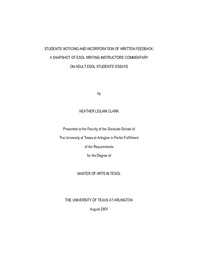| dc.description.abstract | Combining descriptive text analysis with qualitative interviews, the current study addresses the student-teacher written feedback interaction. Reflecting upon the existing debate within second language acquisition research, which focuses on the interface, or non-interface, of conscious and unconscious learning, the first part of the study investigates the role of noticing. Using teacher written commentary on student essays, learners are asked to identify the existence, boundaries, and nature of errors in their interviews. Student interviews are also used to articulate student perspectives on the purposes of feedback. This data illuminates differing opinions between students and teachers. Student essays are further used to analyze the type and location of feedback teachers provide their students, as well as to discriminate the kinds of errors teachers focus on in their written commentary. By looking at first and second drafts, the study investigates the extent to which learners incorporate their teachers' commentary of linguistic features. Instructor interviews expound their reasons for providing feedback, clarify commentary on their learners' papers, and illuminate the instructors' perspectives of their error correction practices. Coding of emergent "error" categories is confirmed by the interviews and instructors' commentary on the students' essays. Seven instructors and 33 students from four post-secondary educational institutions located in the southern part of the United States participated in the study. The current study finds that instructor commentary often facilitates the student's ability to identify the existence of an error; however, it usually fails to facilitate the learner's ability to identify the boundaries or nature of an error. Additionally, 90% of linguistic-focused teacher commentary occurs intralineally, with textual markings and explicit corrections as primary types of feedback. However, textual markings are less explicit, and therefore, more frequently misinterpreted by students. Students incorrectly incorporated or did not incorporate instructor feedback 26% of the time. Teacher inconsistencies may have attributed to these difficulties. | en_US |

